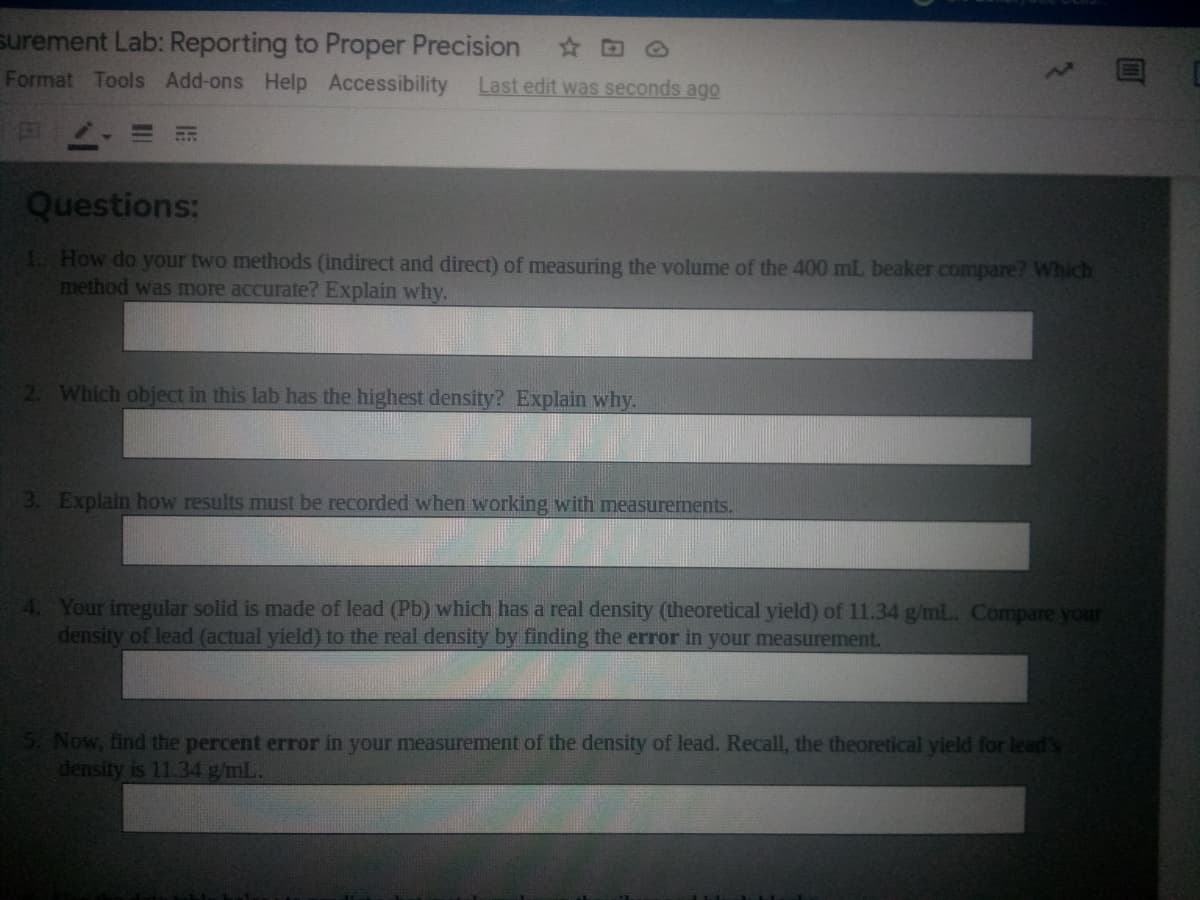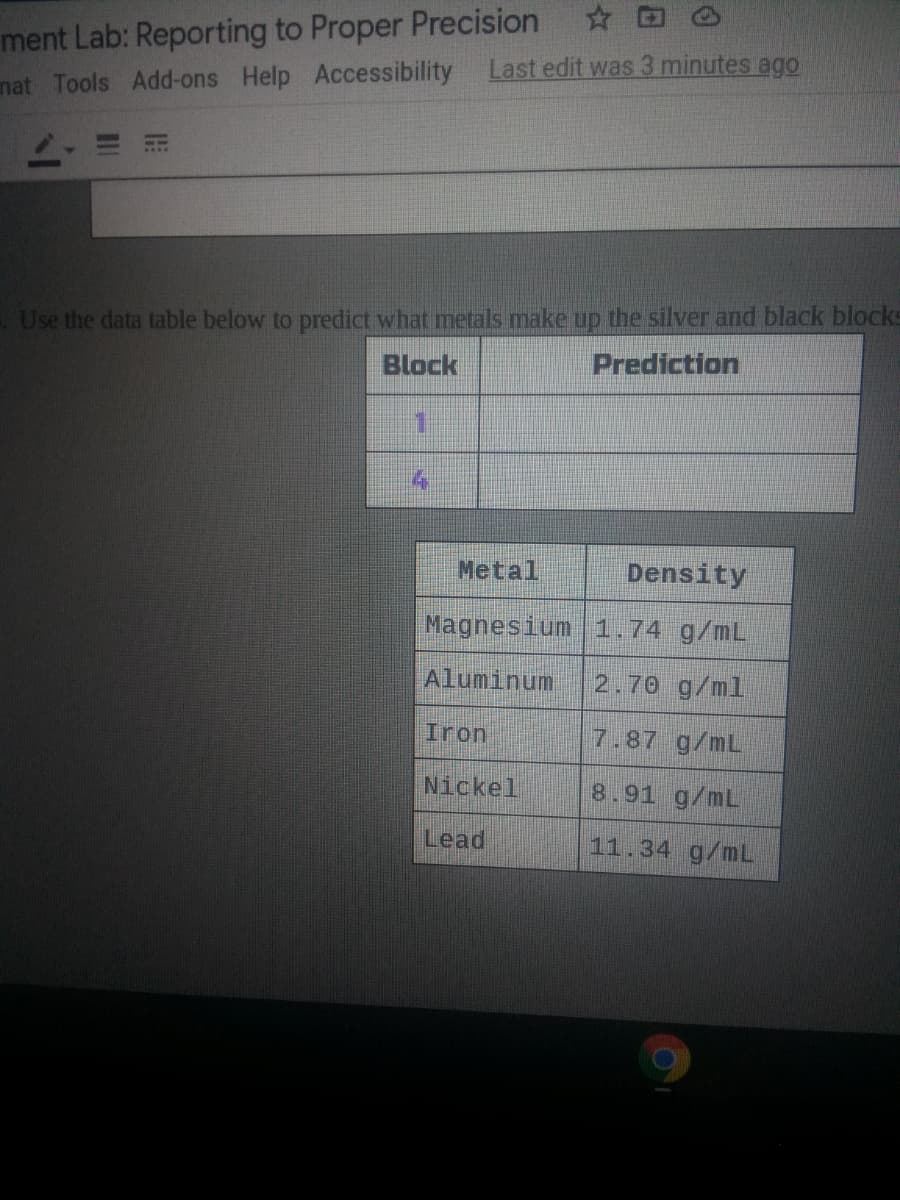ab. Reporting Proper Tools Add-ons Help Accessibility Last edit was seconds ago HE estions: Ow do your two methods (indirect and direct) of measuring the volume of the 400 mL beaker compare? Which ethod was more accurate? Explain why.
ab. Reporting Proper Tools Add-ons Help Accessibility Last edit was seconds ago HE estions: Ow do your two methods (indirect and direct) of measuring the volume of the 400 mL beaker compare? Which ethod was more accurate? Explain why.
Macroscale and Microscale Organic Experiments
7th Edition
ISBN:9781305577190
Author:Kenneth L. Williamson, Katherine M. Masters
Publisher:Kenneth L. Williamson, Katherine M. Masters
Chapter8: Thin-layer Chromatography: Analyzing Analgesics And Isolating Lycopene From Tomato Paste
Section: Chapter Questions
Problem 12Q
Related questions
Question
100%
Chemistry

Transcribed Image Text:surement Lab: Reporting to Proper Precision
Format Tools Add-ons Help Accessibility
Last edit was seconds ago
Questions:
1. How do your two methods (indirect and direct) of measuring the volume of the 400 mL beaker compare? Which
method was more accurate? Explain why.
2 Which object in this lab has the highest density? Explain why.
3. Explain how results must be recorded when working with measurements.
4. Your iregular solid is made of lead (Pb) which has a real density (theoretical yield) of 11.34 g/mL.. Compare your
density of lead (actual yield) to the real density by finding the error in your measurement.
Now, find the percent error in your measurement of the density of lead. Recall, the theoretical yield for lead's
density is 11.34 g/mL.

Transcribed Image Text:ment Lab: Reporting to Proper Precision
mat Tools Add-ons Help Accessibility
☆回
Last edit was 3 minutes ago
Use the data table below to predict what metals make up the silver and black blocks
Block
Prediction
1
4
Metal
Density
Magnesium 1.74 g/mL
Aluminum
2.70 g/ml
Iron
7.87 g/mL
Nickel
8.91 g/mL
Lead
11.34 g/mL
Expert Solution
This question has been solved!
Explore an expertly crafted, step-by-step solution for a thorough understanding of key concepts.
This is a popular solution!
Trending now
This is a popular solution!
Step by step
Solved in 4 steps

Recommended textbooks for you

Macroscale and Microscale Organic Experiments
Chemistry
ISBN:
9781305577190
Author:
Kenneth L. Williamson, Katherine M. Masters
Publisher:
Brooks Cole

Chemistry: Matter and Change
Chemistry
ISBN:
9780078746376
Author:
Dinah Zike, Laurel Dingrando, Nicholas Hainen, Cheryl Wistrom
Publisher:
Glencoe/McGraw-Hill School Pub Co

Introductory Chemistry: A Foundation
Chemistry
ISBN:
9781337399425
Author:
Steven S. Zumdahl, Donald J. DeCoste
Publisher:
Cengage Learning

Macroscale and Microscale Organic Experiments
Chemistry
ISBN:
9781305577190
Author:
Kenneth L. Williamson, Katherine M. Masters
Publisher:
Brooks Cole

Chemistry: Matter and Change
Chemistry
ISBN:
9780078746376
Author:
Dinah Zike, Laurel Dingrando, Nicholas Hainen, Cheryl Wistrom
Publisher:
Glencoe/McGraw-Hill School Pub Co

Introductory Chemistry: A Foundation
Chemistry
ISBN:
9781337399425
Author:
Steven S. Zumdahl, Donald J. DeCoste
Publisher:
Cengage Learning